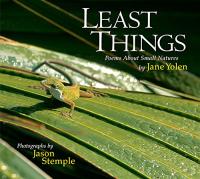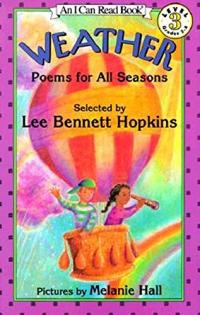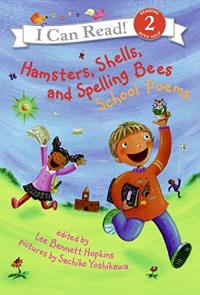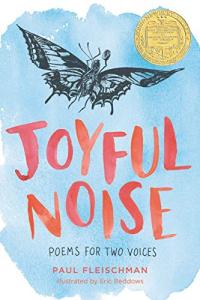
A warm portrait of universal parental love begins on a beach when a boy asks his mother, “How far do you love me?” Lyrical responses combine with stunning double page illustrations in places around the globe until the boy is tucked into bed with his response: “I love you to the moon!” A world map and the query in each language conclude this tender book.
How Far Do You Love Me?

In this springtime tale, a young girl and her father plant a flower box together.
Flower Garden

Short poems (haiku) were written in response to but also evoke creatures shown in crisp close-up photographs of small animals and insects in their natural surroundings. This collection and others by Yolen/Stemple introduce information about nature, and could be used as part of the science curriculum.
Least Things: Poems about Small Natures

Easier to read poems focus on weather and seasons.
Weather: Poems for All Seasons

Tongue twisters abound in this lively and easy to read book by the famous doctor.
Fox in Socks

Familiar subjects are presented in short poems by a range of writers. These easier-to read works are just right to encourage careful listening.
Hamsters, Shells, and Spelling Bees: School Poems

These poems introduce various insects and their lives; ideal for sharing aloud and for relating to informational books on insects.
Joyful Noise: Poems for Two Voices

Over in the meadow live animals and their young – from one to 10. The predictable pattern is made memorable with intricate illustration and repetition in this ageless rendition of a familiar counting ditty.
Over in the Meadow

A celebration of Pullman porters is the focus of this new picture-book edition of Langston Hughes’ classic poem. The collage spreads, blending oil paintings and cut paper, begin with an image of a speeding train before moving on to large portraits of African American porters serving white passengers aboard a luxury train. When the passengers leave, the porters gather left-behind items — newspapers, blues and jazz albums — and toss them from the train. Carried by the wind, the words and music fall into the hands of African Americans across the country. Winner of the 2013 Coretta Scott King Illustrator Award. [From Booklist]
I, Too, Am America

Product Description: Alma Flor Ada’s groundbreaking bilingual collection of rhymes from Spain and Latin America repackaged with a compact disc containing recordings of the included pieces.
¡Pío Peep! Book and CD

Morning routines may never seem the same after sharing day’s start with a small, chubby knight in armor and his long-eared dog who climb a ladder to wake up large dragons. Cheerful, bright, amusing illustrations and catchy rhymes propel readers to the satisfying start of the day.
Waking Dragons

Additional verses are added to the familiar ditty and illustrated in the artist’s signature naïve style. The little star sparkles, flickers, shimmers, and glistens around the whole world watched by animal parents and their young in different settings ending with a human baby and mother.
Twinkle, Twinkle, Little Star

It’s hard to resist babies and baby toes which are “a hundred times sweeter than one could suppose.” A sweet, rhyming homage to babies, families, and a lifetime of affection is presented here with textured, softly colored illustrations.
Ten Tiny Toes

A collection of early Golden Books illustrated by an artist who (as stated in the introduction) influenced Disney films are presented in a new, larger format. Though retro in feel (and reality) the playful stories, poems and songs effectively capture the joy in simple things.
A Mary Blair Treasure of Golden Books

Short, rhyming verse combines with outdoor scenes as a boy and his dad share a camping trip. Their day is presented from fishing to cooking their dinner, until the boy — with “Nodding head/Time for bed” — is carried into their tent by his dad.
In the Woods

Ducks don daring socks for their weekly Duck Sock Hop. Colorful, textured illustrations of ducks in top hats and amazing socks dance through the pages, an effective accompaniment to the alliterative, animated rhymes.
Duck Sock Hop

Lillian, Tilly, and William J. start their energetic adventure when “They choose a spot. They spot some ewes.” The homophones and silliness continue until the exhausted cats relax with a good book. Boldly shaped, colorful illustrations illuminate the animated, rhythmic language.
Cat Tale

There’s a lot going on around the farm from sun-up to sundown. It’s described here with onomatopoeic sounds, jaunty rhymes, and illustrations reminiscent of times past. Children are sure to join in and laugh with the sprightly telling.
Cock-a-Doodle-Doo, Creak, Pop-Pop, Moo

Vivid paintings by San artists, an artists’ project of Botswana, accompany an original story about the ostrich that finds his voice and changes the veld. Lyrical language will read aloud well and evokes a strong sense of place.
Ostrich and Lark

Recognizable constructions from childhood such as blocks and sandcastles and playful verse are juxtaposed to actual photos of architectural landmarks from around the globe. A note about the structure and the architects conclude this imaginative look at art and architecture.
Dreaming Up: A Celebration of Building

Solid colored pages with die-cuts to peek through to busy spreads and cheery rhymes encourage readers to look closely to try to find what is hidden. Settings differ and objects abound in this playful game book.
Look! Another Book

Words are everywhere and so, too, are poems; that is, if you know how to look. Those included in this small, illustrated anthology have been compiled from words in likely and unlikely locations to present a range of topics, sure to inspire young readers to find poems of their own.
The Arrow Finds Its Mark: A Book of Found Poems

Madcap illustrations bring hilarious new life to the 1962 song, “Monster Mash.” It all begins with a bulbous scientist “working in the lab late one night” when his monster arose from his slab and begins to dance the monster mash. Other monsters — and finally two human children — join the green Frankenstein-like critter for colorful, frenzied fun.
Monster Mash

A trick-or-treater leaves the city for a forest of bones and a deliciously creepy Halloween adventure. No number of skeletons can scare this child who shakes his own bones and is rewarded after he chants, “Trick or treat! Smell my feet! Give me something good to eat!” Lively illustration adds detail to the rhythmic text, ideal for reading aloud.
